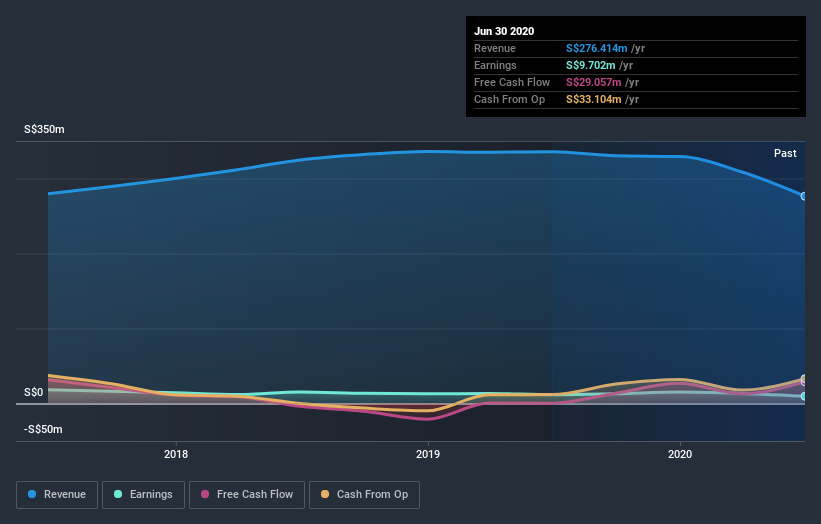
A look at the shareholders of Tai Sin Electric Limited (SGX:500) can tell us which group is most powerful. Institutions often own shares in more established companies, while it's not unusual to see insiders own a fair bit of smaller companies. I quite like to see at least a little bit of insider ownership. As Charlie Munger said 'Show me the incentive and I will show you the outcome.
Tai Sin Electric is not a large company by global standards. It has a market capitalization of S$140m, which means it wouldn't have the attention of many institutional investors. Taking a look at our data on the ownership groups (below), it seems that institutions don't own shares in the company. We can zoom in on the different ownership groups, to learn more about Tai Sin Electric.
Check out our latest analysis for Tai Sin Electric

What Does The Lack Of Institutional Ownership Tell Us About Tai Sin Electric?
Institutional investors often avoid companies that are too small, too illiquid or too risky for their tastes. But it's unusual to see larger companies without any institutional investors.
There are multiple explanations for why institutions don't own a stock. The most common is that the company is too small relative to funds under management, so the institution does not bother to look closely at the company. It is also possible that fund managers don't own the stock because they aren't convinced it will perform well. Tai Sin Electric's earnings and revenue track record (below) may not be compelling to institutional investors -- or they simply might not have looked at the business closely.

Tai Sin Electric is not owned by hedge funds. Looking at our data, we can see that the largest shareholder is the CEO Boon Hock Lim with 16% of shares outstanding. Boon Chin Lim is the second largest shareholder owning 9.3% of common stock, and Chye Huat Lim holds about 6.6% of the company stock. Interestingly, the third-largest shareholder, Chye Huat Lim is also a Chairman of the Board, again, indicating strong insider ownership amongst the company's top shareholders.
We also observed that the top 8 shareholders account for more than half of the share register, with a few smaller shareholders to balance the interests of the larger ones to a certain extent.
While it makes sense to study institutional ownership data for a company, it also makes sense to study analyst sentiments to know which way the wind is blowing. As far I can tell there isn't analyst coverage of the company, so it is probably flying under the radar.
Insider Ownership Of Tai Sin Electric
The definition of an insider can differ slightly between different countries, but members of the board of directors always count. The company management answer to the board and the latter should represent the interests of shareholders. Notably, sometimes top-level managers are on the board themselves.
Most consider insider ownership a positive because it can indicate the board is well aligned with other shareholders. However, on some occasions too much power is concentrated within this group.
Our information suggests that insiders own more than half of Tai Sin Electric Limited. This gives them effective control of the company. That means they own S$87m worth of shares in the S$140m company. That's quite meaningful. It is good to see this level of investment. You can check here to see if those insiders have been buying recently.
General Public Ownership
The general public holds a 38% stake in Tai Sin Electric. While this size of ownership may not be enough to sway a policy decision in their favour, they can still make a collective impact on company policies.
Next Steps:
It's always worth thinking about the different groups who own shares in a company. But to understand Tai Sin Electric better, we need to consider many other factors. Be aware that Tai Sin Electric is showing 2 warning signs in our investment analysis , and 1 of those doesn't sit too well with us...
Of course this may not be the best stock to buy. Therefore, you may wish to see our free collection of interesting prospects boasting favorable financials.
NB: Figures in this article are calculated using data from the last twelve months, which refer to the 12-month period ending on the last date of the month the financial statement is dated. This may not be consistent with full year annual report figures.
If you’re looking to trade Tai Sin Electric, open an account with the lowest-cost* platform trusted by professionals, Interactive Brokers. Their clients from over 200 countries and territories trade stocks, options, futures, forex, bonds and funds worldwide from a single integrated account. Promoted
Valuation is complex, but we're here to simplify it.
Discover if Tai Sin Electric might be undervalued or overvalued with our detailed analysis, featuring fair value estimates, potential risks, dividends, insider trades, and its financial condition.
Access Free AnalysisThis article by Simply Wall St is general in nature. It does not constitute a recommendation to buy or sell any stock, and does not take account of your objectives, or your financial situation. We aim to bring you long-term focused analysis driven by fundamental data. Note that our analysis may not factor in the latest price-sensitive company announcements or qualitative material. Simply Wall St has no position in any stocks mentioned.
*Interactive Brokers Rated Lowest Cost Broker by StockBrokers.com Annual Online Review 2020
Have feedback on this article? Concerned about the content? Get in touch with us directly. Alternatively, email editorial-team@simplywallst.com.
About SGX:500
Tai Sin Electric
Manufactures and deals in cable and wire products in Singapore, Malaysia, Brunei, Vietnam, Indonesia, Myanmar, Cambodia, Thailand, and internationally.
Solid track record with excellent balance sheet.
Market Insights
Community Narratives



